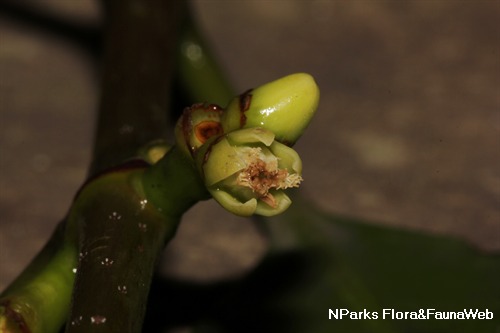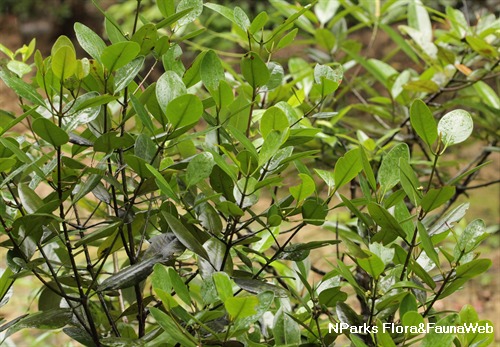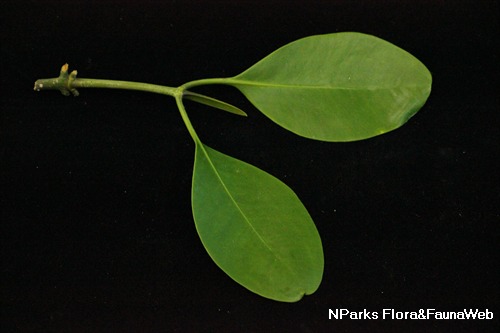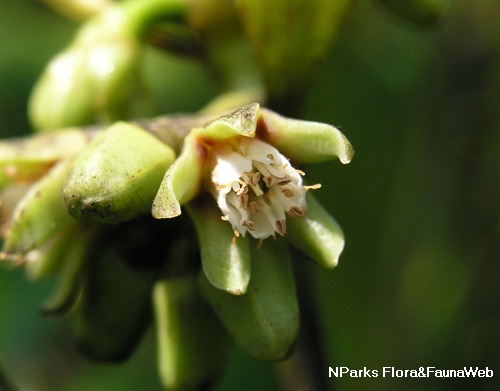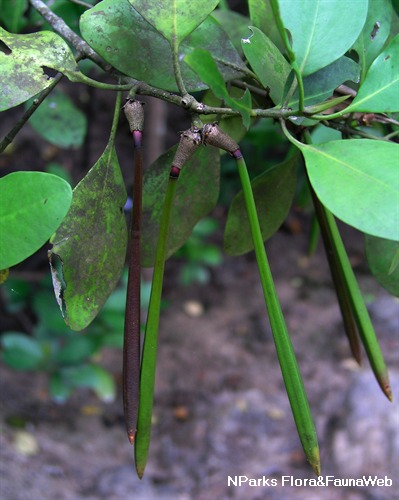
Name
Classifications and Characteristics
| Plant Division | Angiosperms (Flowering Seed Plants) |
|---|---|
| Plant Growth Form | Tree (Small (6m-15m)) |
| Lifespan (in Singapore) | Perennial |
| Mode of Nutrition | Autotrophic |
Biogeography
| Native Distribution | Southeast Asia, including Singapore, Australia and Papua New Guinea |
|---|---|
| Native Habitat | Shoreline (Mangrove Forest) |
| Preferred Climate Zone | Tropical, Sub-Tropical / Monsoonal |
| Local Conservation Status | Native to Singapore (Endangered (EN)) |
Description and Ethnobotany
| Growth Form | Small tree, may reach up to 10 - 12 m. |
|---|---|
| Trunk | Greyish brown bark, protruding lenticels on surface and flaky base. |
| Roots | Small stilt roots present at the base of the trunk. |
| Foliage | Oval to oval-elliptical leaves, opposite, measuring 5.5 - 11 cm by 3 - 7.5 cm, leaf stalk about 1 - 2.5 cm long. |
| Flowers | 3 - 5 axillary flowers in an inflorescence bearing at the uppermost three nodes of a branch, 5 calyx lobes, erect while in flowering, 4 white petals, turning brown quickly, 10 stamens almost equal in size, filament about 1 mm long, anther about 1 mm long, ovary inferior and 3 chambered with 2 ovules in each chamber, style about 2 mm long. |
| Fruit | Brown ovoid-conical fruit with brown patterns on the surface. Propagule with angular ridges, gradually thickening with an acute sharp apex, measuring 8 - 17 cm long. Characteristic red collar below the calyx. |
| Habitat | Occurs in the mid to high intertidal zone in intermediate regions of estuaries. |
| Etymology | Ceriops in Latin originated from the Greek word Ceras-opsis which means horn-like appearance. The horn-like appearance draws resemblance to the small hypocotyl shape. zippeliana is named after Dutch botanist Alexander Zippelius (1797 - 1828). |
Landscaping Features
| Desirable Plant Features | Ornamental Flowers |
|---|---|
| Landscape Uses | Coastal Plant, Riverine |
Fauna, Pollination and Dispersal
| Seed or Spore Dispersal | Abiotic |
|---|
Plant Care and Propagation
| Light Preference | Full Sun |
|---|---|
| Water Preference | Lots of Water |
| Plant Growth Rate | Moderate |
| Rootzone Tolerance | Moist Soils, Waterlogged Soils, Saline Soils / Salt Spray |
| Propagation Method | Viviparious Propagule |
Foliar
| Foliage Retention | Evergreen |
|---|---|
| Mature Foliage Colour(s) | Green |
| Foliar Type | Simple / Unifoliate |
| Foliar Arrangement Along Stem | Opposite |
| Foliar Attachment to Stem | Petiolate |
| Foliar Shape(s) | Non-Palm Foliage (Oval, Elliptical) |
| Foliar Venation | Pinnate / Net |
| Foliar Margin | Entire |
| Foliar Apex - Tip | Obtuse |
| Foliar Base | Cuneate |
Floral (Angiosperm)
| Flower & Plant Sexuality | Bisexual Flowers |
| Flower Colour(s) | Cream / Off-White |
|---|---|
| Flower Grouping | Cluster / Inflorescence |
| Flower Location | Axillary |
Fruit, Seed and Spore
| Mature Fruit Colour(s) | Brown |
|---|
Image Repository
Others
| Master ID | 32135 |
|---|---|
| Species ID | 6541 |
| Flora Disclaimer | The information in this website has been compiled from reliable sources, such as reference works on medicinal plants. It is not a substitute for medical advice or treatment and NParks does not purport to provide any medical advice. Readers should always consult his/her physician before using or consuming a plant for medicinal purposes. |

